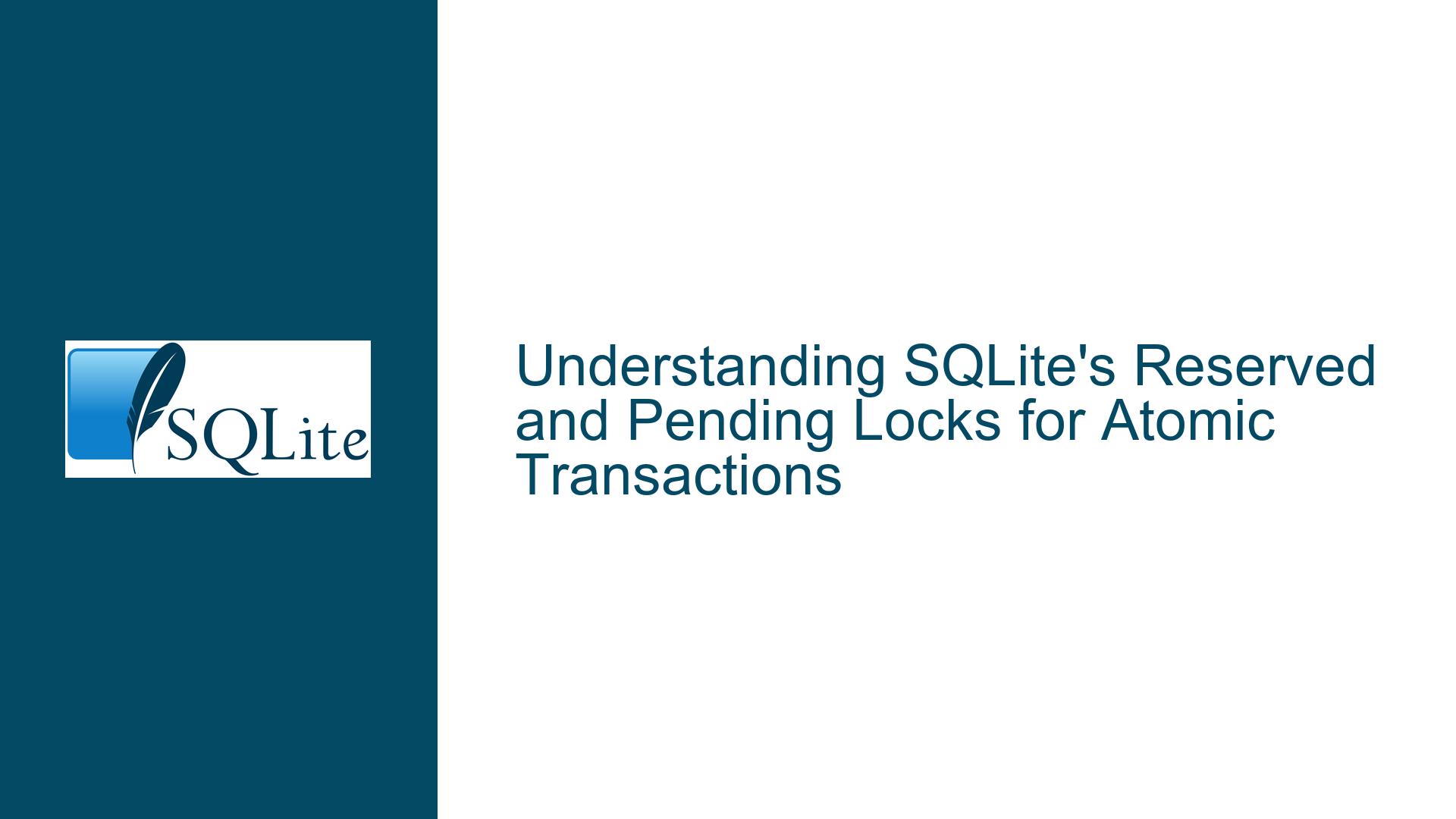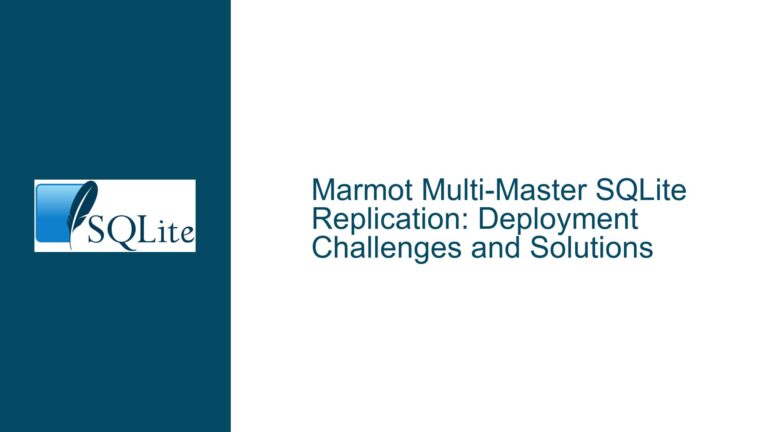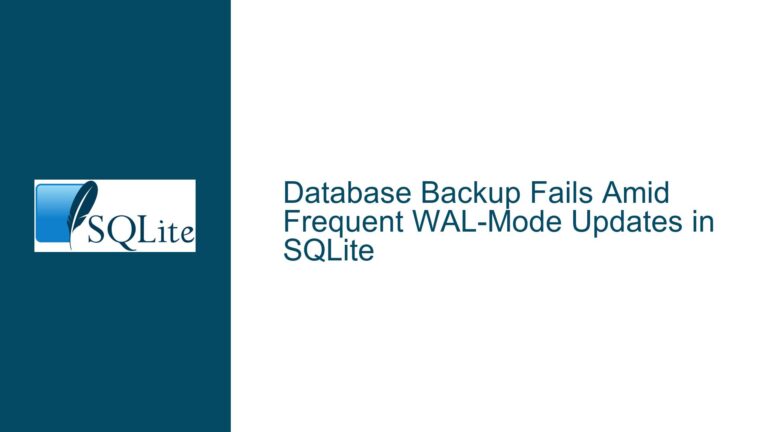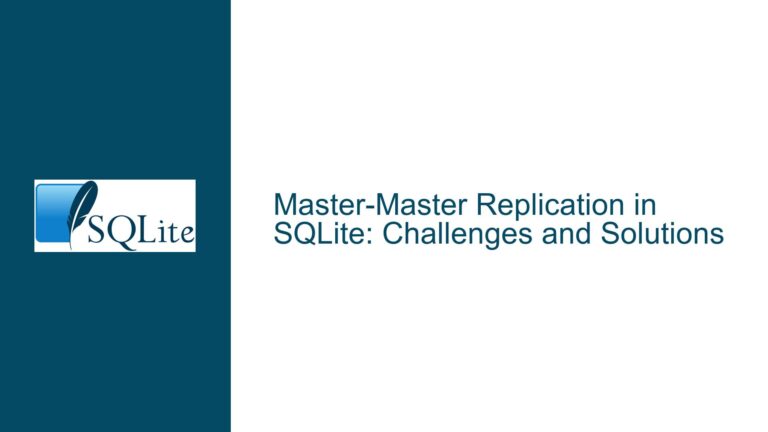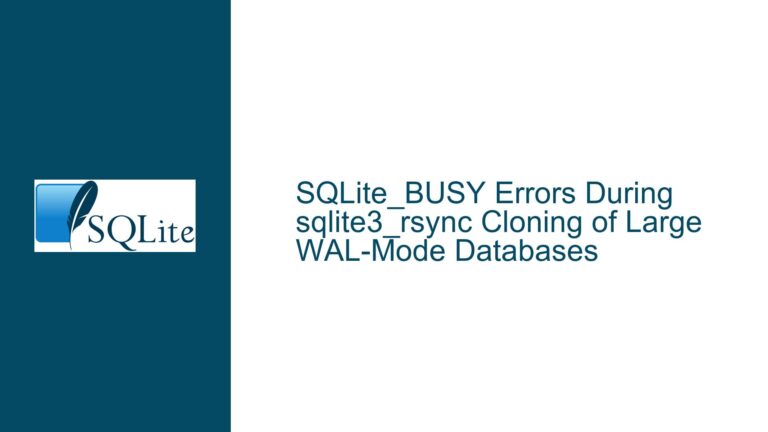SQLite’s Reserved and Pending Locks for Atomic Transactions
Issue Overview: SQLite’s Locking Mechanism and OS-Level Implementation
The core issue revolves around understanding how SQLite implements reserved and pending locks to manage atomic transactions while avoiding writer starvation. These locks are critical for ensuring that multiple processes or threads can safely read from and write to a database file without data corruption. However, confusion arises because these locks are not natively supported by operating system (OS) file-locking APIs (e.g., Windows’ LockFileEx or Rust crates like fs4). Instead, SQLite implements them as abstractions built on top of basic OS-provided shared and exclusive locks. This creates a disconnect for developers attempting to replicate SQLite’s locking strategy in custom database systems, as the OS does not explicitly recognize "reserved" or "pending" states.
Key Technical Details
Lock Types in SQLite:
- Shared (SHARED): Allows multiple readers to access the database.
- Reserved (RESERVED): A transitional lock acquired by a writer to signal intent to modify the database. This does not block readers but prevents other writers.
- Pending (PENDING): A stronger lock that blocks new shared locks (readers) while allowing existing readers to finish.
- Exclusive (EXCLUSIVE): Grants full write access; no other locks are allowed.
Writer Starvation Prevention:
SQLite uses pending locks to ensure that once a writer is ready to commit, new readers cannot acquire shared locks. This prevents infinite deferral of writes (starvation).OS Abstraction Layer:
SQLite’sos_unix.c(Unix-like systems) andos_win.c(Windows) modules map these higher-level locks to OS-specific byte-range locks. For example, reserved and pending locks are implemented by locking specific bytes in the database file, which act as semaphores.
Why This Confusion Arises
Most OS file-locking APIs only recognize shared (read) and exclusive (write) locks. Developers working with Rust crates like fs4 or Windows’ LockFileEx encounter no direct support for reserved/pending states. SQLite’s documentation and source code reveal that these states are emulated by strategically placing exclusive locks on specific byte offsets. This design is non-obvious unless one examines SQLite’s internal implementation.
Possible Causes: Misalignment Between SQLite’s Locking Model and OS Primitives
OS Locking Primitives Lack Higher-Level Semantics
Operating systems provide basic shared/exclusive locks but do not natively support intermediate states like "reserved" or "pending." SQLite’s locking model is a protocol built atop these primitives. For example:- A reserved lock might correspond to an exclusive lock on byte offset
0x40. - A pending lock might involve an exclusive lock on byte offset
0x41.
Other processes check these offsets to infer the database’s lock state.
- A reserved lock might correspond to an exclusive lock on byte offset
Rust Crates Abstract Away Byte-Range Locking
Rust’sfs4crate provides cross-platform file locking but simplifies the interface to whole-file locks. Developers must manually implement byte-range locking to replicate SQLite’s strategy.Ambiguity in SQLite’s Source Code
SQLite’swinFilestruct tracks lock states (e.g.,eLock), but the actual OS calls (e.g.,LockFileEx) are buried in helper functions. For instance,winLockinos_win.citerates through lock levels, usingLockFileExto acquire exclusive locks on predefined offsets.Misunderstanding the Role of Byte-Range Locks
SQLite uses a locking protocol where specific bytes act as flags:- Shared Lock Range: Multiple readers lock distinct random bytes within a predefined range (e.g.,
0x10–0x7F). - Reserved Lock: An exclusive lock on a fixed byte (e.g.,
0x40). - Pending Lock: An exclusive lock on another fixed byte (e.g.,
0x41). - Exclusive Lock: Locks the entire file.
This protocol is not documented in OS APIs, leading to confusion when developers expect reserved/pending locks to map to OS-level constructs.
- Shared Lock Range: Multiple readers lock distinct random bytes within a predefined range (e.g.,
Troubleshooting Steps, Solutions & Fixes: Replicating SQLite’s Locking Strategy
Step 1: Understand SQLite’s Byte-Range Locking Protocol
SQLite’s locking mechanism is a state machine driven by byte-range locks. To replicate this:
Define Lock Regions:
- Reserve a block of bytes (e.g.,
0x10–0x7F) for shared locks. - Dedicate fixed offsets for reserved (
0x40) and pending (0x41) locks.
- Reserve a block of bytes (e.g.,
Acquire Shared Locks:
Readers lock a random byte within the shared range. This allows multiple readers by ensuring they don’t conflict.Transition to Reserved Lock:
A writer acquires an exclusive lock on0x40. This does not block readers but signals intent to write.Upgrade to Pending Lock:
The writer acquires an exclusive lock on0x41. This blocks new readers (they check0x41before acquiring shared locks).Wait for Existing Readers:
The writer waits until all shared locks (random bytes) are released.Acquire Exclusive Lock:
The writer locks the entire file, commits changes, and releases all locks.
Step 2: Implement Custom Locking in Rust
Using fs4 or std::fs::File, manually manage byte ranges:
use std::fs::OpenOptions;
use std::os::windows::fs::OpenOptionsExt;
use std::os::windows::io::AsRawHandle;
use winapi::um::fileapi::{LockFileEx, UnlockFile, LOCKFILE_EXCLUSIVE_LOCK, LOCKFILE_FAIL_IMMEDIATELY};
use winapi::um::minwinbase::OVERLAPPED;
// Define lock regions
const SHARED_START: u64 = 0x10;
const SHARED_END: u64 = 0x7F;
const RESERVED_BYTE: u64 = 0x40;
const PENDING_BYTE: u64 = 0x41;
fn acquire_shared(file: &std::fs::File) {
let mut overlapped = OVERLAPPED::default();
let mut range = (SHARED_START + rand::random::<u64>() % (SHARED_END - SHARED_START)) as u64;
unsafe {
LockFileEx(
file.as_raw_handle(),
0, // Shared lock
0,
1, // Lock 1 byte
0,
&mut overlapped,
);
}
}
fn acquire_reserved(file: &std::fs::File) {
let mut overlapped = OVERLAPPED::default();
overlapped.Offset = RESERVED_BYTE as u32;
overlapped.OffsetHigh = (RESERVED_BYTE >> 32) as u32;
unsafe {
LockFileEx(
file.as_raw_handle(),
LOCKFILE_EXCLUSIVE_LOCK,
0,
1,
0,
&mut overlapped,
);
}
}
Step 3: Handle Writer Starvation with Pending Locks
To prevent new readers once a writer is ready:
Check Pending Byte Before Shared Locks:
Readers must attempt a non-blocking check on the pending byte (0x41). If locked, they wait.Acquire Pending Lock Exclusively:
Writers lock0x41after acquiring the reserved lock. This blocks new readers.
Step 4: Test for Deadlocks and Edge Cases
- Deadlock Prevention: Ensure writers release pending locks if they cannot upgrade to exclusive.
- Portability: Use conditional compilation for Unix (e.g.,
fcntl) and Windows (LockFileEx).
Step 5: Integrate with Transaction Management
- Begin Transaction: Acquire shared lock.
- Prepare to Commit: Acquire reserved, then pending.
- Commit: Acquire exclusive lock, write, release all.
By dissecting SQLite’s use of byte-range locks as semaphores, developers can replicate its atomic commit mechanism in custom databases. The key insight is that reserved/pending locks are not OS-level primitives but a protocol enforced by coordinating exclusive locks on specific bytes.
